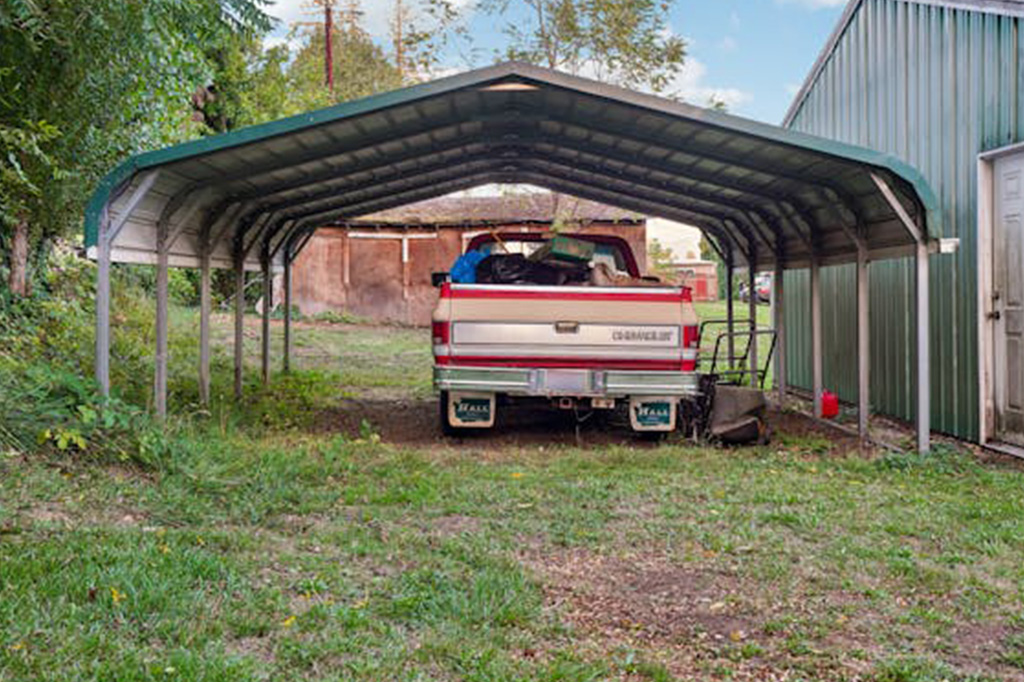Carports are often seen as simple structures designed to shield vehicles from the sun. For many homeowners, the concept of a carport is closely tied to providing shade and preventing interiors from overheating. While this benefit alone is significant, there is much more to a carport’s protective capacity. Carports offer a wide array of benefits that go well beyond shade, ranging from protection against natural elements to contributing to the longevity of your vehicle and even improving property value. This article explores the full spectrum of protection that a carport provides, presenting a clearer picture of why this structure deserves more recognition.
Protection Against Rain and Snow
Vehicles exposed to constant rain and snow are at greater risk of corrosion, rust, and other forms of damage. A carport acts as a first line of defense against precipitation. During rainy seasons, vehicles left in open driveways often accumulate water in small crevices, which may eventually lead to rust. In regions with heavy snowfall, carports prevent snow from building up on the roof of the vehicle, making it easier to use the car during winter months without needing extensive clearing.
In addition to protecting vehicles, carports also help maintain the cleanliness of driveways. Runoff water from rainstorms often brings debris, mud, and dirt, but a carport can minimize this accumulation by blocking direct exposure. This not only makes for a tidier environment but also reduces the amount of time needed for regular maintenance.
Shield from Hail Damage
Hailstorms are unpredictable and can cause substantial damage to vehicles in a matter of minutes. A carport provides a crucial shield during such events. Hailstones vary in size and velocity, but even smaller ones can dent car hoods, roofs, and windshields. The costs associated with repairing hail damage can be high, often exceeding what many expect. Insurance claims from hailstorms are among the most common in areas where this weather pattern occurs regularly. Having a carport in place significantly lowers the chances of such damage, potentially saving thousands in repair bills and helping maintain the car’s resale value.
UV Protection and Paint Preservation
Prolonged exposure to ultraviolet rays can deteriorate a vehicle’s paint and interior materials. Sunlight gradually fades color, dries out leather, and weakens plastic components inside the vehicle. Over time, this degradation becomes more visible and reduces the overall aesthetic appeal and value of the car. Carports block direct sunlight, preserving both the exterior and interior of the vehicle. This form of UV protection is one of the most beneficial aspects of carport coverage, especially for newer models or custom paint jobs.
Reducing Heat Buildup in Vehicles
Cars parked in direct sunlight for long hours absorb a significant amount of heat. This not only makes the vehicle uncomfortable upon entry but also affects internal systems. High cabin temperatures can damage electronic equipment, dashboard materials, and upholstery. A carport helps reduce internal heat buildup, allowing for a more comfortable environment and lowering the stress on air conditioning systems when the car is first started.
Carports offer added comfort by maintaining lower temperatures throughout the day. This is particularly valuable for families with children or pets who may be sensitive to hot interiors. The cooler environment also discourages the growth of bacteria and odor inside the vehicle.
Protection for Other Assets
Carports are not limited to safeguarding cars. They also provide protection for motorcycles, boats, bicycles, and recreational equipment. Many homeowners use their carports to store trailers, lawnmowers, and other tools that would otherwise be left exposed. A well-designed carport accommodates various types of gear, offering the same level of weather protection that vehicles receive.
Families with active outdoor lifestyles benefit significantly from the multipurpose nature of carports. The structure becomes a centralized storage area for seasonal gear such as kayaks, surfboards, or garden supplies, keeping everything in better condition over time. Having these items under cover ensures they remain functional and safe to use when needed.
Energy Efficiency and Home Comfort
Strategically positioned carports can contribute to a home’s overall energy efficiency. When installed adjacent to the house, a carport can block direct sunlight from hitting exterior walls and windows. This leads to reduced indoor temperatures and a lower reliance on air conditioning. Over the long term, homeowners may notice a decrease in energy bills, especially during summer months.
In warmer climates, this indirect cooling effect provides a subtle yet impactful improvement in indoor comfort. Homes remain cooler with less effort from HVAC systems, and the added shade reduces heat spots around the property. As a bonus, carports made from reflective materials can enhance this cooling effect even further.
Increased Property Value
Adding a carport to a home often increases its market appeal. Potential buyers view carports as valuable additions, especially when garages are not available. The additional covered space is seen as a practical investment that adds convenience and protection to daily life. Real estate agents frequently highlight carports as key selling points in property listings, especially in suburban and rural markets.
While not all home improvements yield a return on investment, carports typically enhance the perceived functionality and utility of a property. Buyers appreciate that their vehicles and equipment will be better protected, and that the space serves multiple functions without the expense of building a full garage.
Durability and Long-Term Use
Carports constructed from quality materials such as galvanized steel or aluminum are designed to withstand the test of time. These structures are resistant to rust, insect damage, and high winds. With proper installation and occasional maintenance, a metal carport can last for decades, providing consistent protection across all seasons.
Investing in a durable carport is an assurance of ongoing safety and convenience. Once installed, the structure requires minimal upkeep, often just occasional cleaning and inspection to ensure all bolts and joints remain secure. Longevity becomes one of its defining traits, proving its worth year after year.
Safety for People
Carports offer benefits that go beyond the preservation of vehicles and property. They also contribute to human safety. Walking to a car during a storm or on a snowy morning can be risky. Carports create a buffer zone, reducing the risk of slipping or falling on icy driveways. They also provide shelter when entering or exiting a vehicle during rainstorms.
Families with young children or elderly members gain peace of mind from having a dry, stable area to navigate when moving between the house and vehicle. This sheltered space can also be useful for loading groceries, organizing trips, or simply enjoying the outdoors without direct exposure to sun or rain.
Versatility in Design and Function
Modern carports come in a wide range of designs and materials, allowing them to complement various architectural styles. Homeowners can choose between freestanding or attached models, single or multiple vehicle capacities, and customized dimensions to suit specific needs. Some carports even include side panels or storage units for enhanced usability.
This adaptability ensures that carports meet the needs of diverse lifestyles. A family with multiple cars may choose a larger double carport, while someone with limited space may install a compact single-vehicle structure. This flexibility allows carports to remain functional across different life stages and usage patterns.
Cost-Effective Alternative to Garages
One of the main reasons people choose carports is the cost advantage. Constructing a full garage involves a larger budget, longer timelines, and sometimes complex permitting requirements. Carports, in contrast, are relatively affordable and quicker to install. Despite the lower cost, they still deliver many of the key protective benefits associated with garages.
For homeowners on a budget or those who need a quicker solution, carports serve as a highly effective compromise. They fulfill protective roles without the overhead associated with a permanent building. Over time, this cost-effectiveness makes them an attractive option for property improvement.
Support for Outdoor Projects and Activities
Carports are not limited to storage and vehicle protection. Many homeowners use them as makeshift workspaces or activity areas. The shade and cover make carports ideal for small construction projects, family gatherings, or weekend hobbies. These open-air structures encourage people to spend more time outside without the discomfort of direct sun or surprise weather changes.
As an extension of living space, carports bring additional functionality to a property. They create areas where families can barbecue, repair bikes, or assemble outdoor furniture in a shaded and rain-protected setting. This versatility contributes to the quality of life that homeowners enjoy from their property.
Environmental Considerations
Carports with open sides promote natural airflow and reduce the need for artificial ventilation. In contrast to enclosed garages that can trap fumes and heat, carports allow for quick dispersal of emissions and keep the area fresh. This design supports a healthier environment for both people and parked vehicles.
Some carport owners take this eco-conscious approach even further by installing solar panels on the roof. This not only maximizes the utility of the structure but also contributes to renewable energy goals. The simplicity of adding solar panels makes the carport a functional part of sustainable living strategies.
Community and Neighborhood Benefits
In areas where street parking is limited or prohibited, carports offer a neat and organized alternative. Vehicles are housed in a designated spot that improves neighborhood aesthetics and traffic flow. Organized parking helps reduce clutter and creates a more visually appealing community environment.
Carports also promote better security. Covered areas are more likely to be in view from windows or surveillance systems, which can discourage vandalism and theft. This added visibility fosters a sense of safety and order within the residential area.
Conclusion
The modern carport is far more than a simple shade structure. It provides year-round protection from weather conditions, enhances vehicle longevity, improves home energy efficiency, and adds functional space to the property. With their versatile applications and durable construction, carports serve a wide range of practical needs for homeowners. Understanding the full protection a carport offers leads to better decision-making when planning property improvements. Investing in a carport is not just about providing shade. It is a commitment to preserving assets, improving daily life, and preparing for changing environmental conditions in a cost-effective and efficient way.

